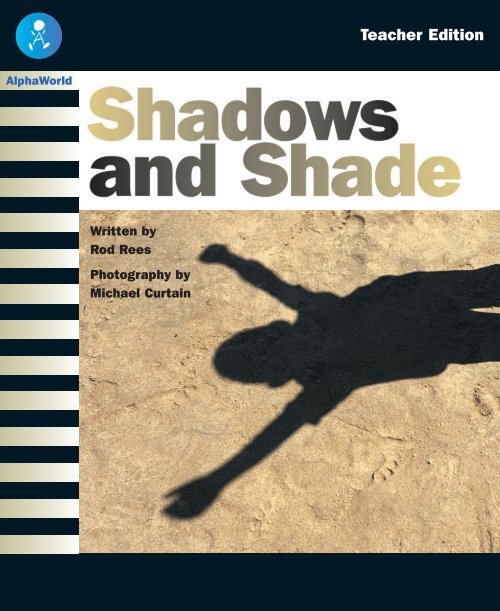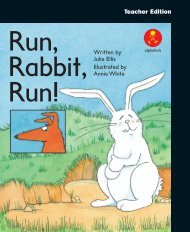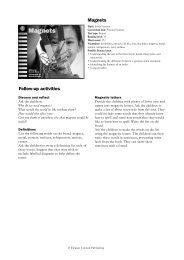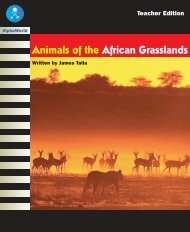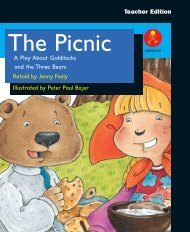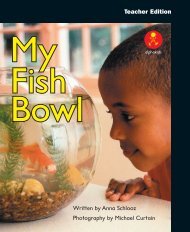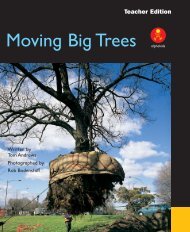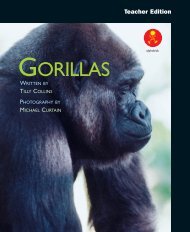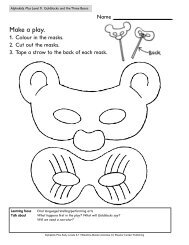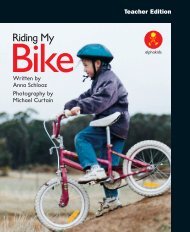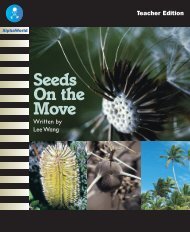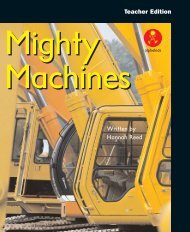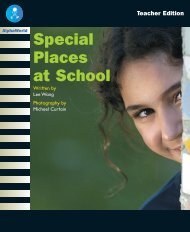Shadows and Shade
Shadows and Shade
Shadows and Shade
Create successful ePaper yourself
Turn your PDF publications into a flip-book with our unique Google optimized e-Paper software.
Teacher Edition<br />
AlphaWorld<br />
Written by<br />
Rod Rees<br />
Photography by<br />
Michael Curtain
Published edition<br />
© Eleanor Curtain<br />
Publishing 2004<br />
Text © Kerrie Shanahan<br />
Photographs © Eleanor<br />
Curtain Publishing<br />
First published 2004<br />
Apart from any fair dealing for<br />
the purposes of study, research,<br />
criticism or review, as<br />
permitted under the Copyright<br />
Act of Australia, no part of this<br />
book may be reproduced by<br />
any process, or transmitted in<br />
any form, without permission<br />
of the copyright owner. Where<br />
copies of part or the whole of<br />
this book are made under Part<br />
VB of the Copyright Act, the<br />
law requires that records of<br />
such copying be kept <strong>and</strong> the<br />
copyright owner is entitled to<br />
claim payment.<br />
Developed by<br />
Eleanor Curtain Publishing<br />
Text: Kerrie Shanahan<br />
Consultant: Susan Hill<br />
Designed by<br />
Alex<strong>and</strong>er Stitt<br />
Production by<br />
Publishing Solutions<br />
Printed in China<br />
ISBN 0 7253 3040 6<br />
1 2 3 4 5 6 7 8 9<br />
04 05 06<br />
?<br />
How to use this book<br />
Before reading: Talkthrough<br />
Talk through the book with the children. Encourage<br />
them to predict the text from the cover <strong>and</strong> the<br />
pictures, <strong>and</strong> to think about the information provided.<br />
Direct the children’s attention to aspects of the text<br />
that may challenge them. Support the children as they<br />
deal with these challenges by asking the Talkthrough<br />
questions on each page.<br />
During reading: Observe <strong>and</strong> support<br />
Observe the children as they read <strong>and</strong> encourage them<br />
to monitor their own reading. Help the children to use<br />
reading strategies <strong>and</strong> cues to respond to reading<br />
challenges that arise in the text. Interruptions to the<br />
child’s reading should be minimal <strong>and</strong> focused on a<br />
specific learning need.<br />
After reading: A range of comprehension<br />
<strong>and</strong> response activities<br />
To develop children’s underst<strong>and</strong>ing of the text, select<br />
from the activities found on page 12 <strong>and</strong> the inside<br />
back cover. These whole text, sentence <strong>and</strong> word level<br />
activities reinforce the teaching focus of this book.<br />
Assessment ideas are provided to assist with further<br />
teaching plans.<br />
Selected text features<br />
• Contents page<br />
• Illustrations <strong>and</strong> photographs support<br />
<strong>and</strong> extend the text<br />
• Double-page spreads for each topic<br />
• Index<br />
Vocabulary<br />
deserts, inside, light, outside, protect, puppets,<br />
shadow, shape, shining, sunburn, sundials
Setting the context<br />
Using a torch <strong>and</strong> a toy or your h<strong>and</strong>, make<br />
a shadow on a wall.<br />
What is the dark mark on the wall called? Why<br />
is it there? Where else have you seen a<br />
shadow?<br />
Front cover<br />
Show the front cover.<br />
This book is called <strong>Shadows</strong> <strong>and</strong> <strong>Shade</strong>.<br />
What is this the shadow of?<br />
How are shadows made?<br />
What do you expect to learn from reading this<br />
book?<br />
Title page<br />
Turn to the title page.<br />
What is making the shadow in this<br />
photograph?<br />
What else is on the title page?<br />
1
<strong>Shadows</strong> <strong>and</strong> <strong>Shade</strong> Pages 2–5<br />
?<br />
Talkthrough<br />
Turn to the contents page.<br />
This is the contents page. A contents page tells us what<br />
information is in a book.<br />
Read the table of contents to the children.<br />
What can you see in the pictures on this page?<br />
Turn to pages 4–5<br />
This diagram shows how shadows are made. A tree blocking the<br />
light makes a shadow.<br />
What is blocking the light in this photograph?<br />
Observe <strong>and</strong> support<br />
Ask a child who is having difficulty to read aloud to you. Does<br />
the child pay attention to punctuation to support expressive<br />
reading?<br />
Where is the question mark?<br />
What does this tell you about how to read the sentence?<br />
Can you see the paragraph break?<br />
What do you do when you are reading aloud <strong>and</strong> you come to a<br />
paragraph break?<br />
2
<strong>Shadows</strong> <strong>and</strong> <strong>Shade</strong> Pages 6–9<br />
?<br />
Talkthrough<br />
Turn to pages 6–7<br />
What can make a shadow during the day?<br />
What can make a shadow at night?<br />
Turn to pages 8–9<br />
This diagram shows how a shadow changes as the sun moves.<br />
What times of the day does it show?<br />
This photograph is of a sundial. Sundials were once used to tell<br />
the time. How do you think they work?<br />
How do we usually tell the time?<br />
Observe <strong>and</strong> support<br />
Can the children use the text, the diagrams <strong>and</strong> the<br />
photographs to underst<strong>and</strong> the text at the literal level?<br />
Where can you see shadows?<br />
What makes shadows?<br />
The text tells us that shadows change as the sun moves. Why<br />
does this happen?<br />
What are sundials used for?<br />
How does a sundial work?<br />
4
<strong>Shadows</strong> <strong>and</strong> <strong>Shade</strong> Pages 10–13<br />
?<br />
Talkthrough<br />
Turn to pages 10–11<br />
This section is called ‘Using shadows for shade’.<br />
These people are using hats to shade their faces from the sun.<br />
What other things do people use to shade themselves from the<br />
sun?<br />
Why do we need shade?<br />
Turn to pages 12–13<br />
Animals use shade to protect themselves from the sun.<br />
Where have the animals in these photographs found shade?<br />
Where else could animals find shade?<br />
Observe <strong>and</strong> support<br />
Can the children use their knowledge of phonics to solve<br />
problems when reading?<br />
You read the word ‘protect’. How did you know this word was<br />
‘protect’?<br />
What did you check?<br />
What did you think about?<br />
When needed, you might say:<br />
Look at the start of the word. What sound might the first two<br />
letters make?<br />
Check the end of the word.<br />
What word starting with the /pr/ sound would make sense here?<br />
6
<strong>Shadows</strong> <strong>and</strong> <strong>Shade</strong> Pages 14–17<br />
?<br />
Talkthrough<br />
Turn to pages 14–15<br />
Some plants don’t like too much sun. Where do these plants<br />
grow?<br />
Turn to pages 16–17<br />
These children are using their bodies to make shadows. What do<br />
these shadows look like?<br />
What shapes can you make?<br />
Observe <strong>and</strong> support<br />
Can the children use information from the text <strong>and</strong> the<br />
photographs to underst<strong>and</strong> the meaning of new words such as<br />
‘cactus’?<br />
You read the word ‘cactus’. What are cactus plants?<br />
How did you work that out?<br />
8
<strong>Shadows</strong> <strong>and</strong> <strong>Shade</strong> Pages 18–20<br />
?<br />
Talkthrough<br />
Turn to pages 18–19<br />
This section is about shadow puppets.<br />
Shadow puppets can be used to tell a story.<br />
Look at the diagram. Where is the light?<br />
Where is the puppet?<br />
Where can the audience see the shadow made by the puppet?<br />
Turn to page 20<br />
This is an index. An index helps us to find information in a book.<br />
When might you use an index?<br />
Observe <strong>and</strong> support<br />
Are the children able to point out different features in the text?<br />
Where is the section heading?<br />
Why would a book like this have section headings?<br />
What is the heading on this page?<br />
What is the purpose of an index?<br />
10
<strong>Shadows</strong> <strong>and</strong> <strong>Shade</strong><br />
After reading<br />
Being a meaning maker<br />
Encourage the children to support<br />
their answers to these questions with<br />
evidence from the book:<br />
What is a shadow?<br />
What is needed to make a shadow?<br />
Where can you find shadows?<br />
How can shadows help us to tell the<br />
time?<br />
How can shadows help to protect us?<br />
How do animals <strong>and</strong> plants protect<br />
themselves from the sun?<br />
Why is shade important to us?<br />
Being a code breaker<br />
Explore the following language<br />
features:<br />
• Hearing sounds: words that contain<br />
the /sh/ sound – bushes, shade,<br />
shadow, shape, shining, shows<br />
• Vocabulary: words with the word<br />
‘sun’ in it – sunburn, sundials, sunny<br />
• Punctuation: capital letters, commas,<br />
full stops, question marks<br />
• Words that describe opposites:<br />
cool/warm, night/day, outside/inside<br />
Being a text user<br />
What type of text is this: narrative or<br />
information?<br />
What does this book teach you?<br />
Do you need to read this book from the<br />
start to the finish? Why?<br />
Being a text critic<br />
What did the author need to know<br />
before writing this book?<br />
How might the author have found this<br />
information?<br />
How could we check if the information<br />
is correct?<br />
12
Responding to text<br />
The children could make their own<br />
sundial using strong cardboard <strong>and</strong><br />
tape. They could put it outside <strong>and</strong> watch<br />
how the shadows change. Using a torch<br />
against a white background, the children<br />
could also try to make moving shadows with<br />
their h<strong>and</strong>s.<br />
The children could go outside on a<br />
sunny day <strong>and</strong> make shadows. Each<br />
child could draw a labelled diagram of a<br />
friend <strong>and</strong> his/her shadow. They could then<br />
swap roles.<br />
Writing links<br />
Model how to take notes from a factual text.<br />
Ask the children to help you identify the<br />
main points made on each page. Write these<br />
down as you go.<br />
The children could write a list of all the<br />
things they know about shadows <strong>and</strong> shade.<br />
They could compare lists with a partner. A<br />
class list of statements about shadows <strong>and</strong><br />
shade could be compiled.<br />
The children could list all of the words<br />
from the book that have the /sh/ sound.<br />
They could add to their lists by looking<br />
through other familiar texts.<br />
Possible assessment focus<br />
Can the children:<br />
• underst<strong>and</strong> the text at the literal level?<br />
• discuss information about shadows <strong>and</strong> shade with<br />
reference to both the photographs <strong>and</strong> the illustrations?<br />
• locate words in the text that contain the /sh/ sound?<br />
whole text activity sentence activity word activity
<strong>Shadows</strong> <strong>and</strong> <strong>Shade</strong><br />
Topic: Light/ Science<br />
Curriculum link: Physical Science<br />
Text type: Report<br />
Reading level: 12<br />
Word count: 315<br />
Vocabulary: deserts, inside, light, outside,<br />
protect, puppets, shadow, shape, shining,<br />
sunburn, sundials<br />
Possible literacy focus:<br />
• Underst<strong>and</strong>ing how shadows are made.<br />
• Interpreting information in photographs <strong>and</strong><br />
illustrations.<br />
• Identifying words that contain the /sh/<br />
sound.<br />
Summary<br />
This book explains how shadows are made <strong>and</strong><br />
how they are used by people <strong>and</strong> animals.<br />
ESL possibilities:<br />
• Recognise the book as a factual text <strong>and</strong><br />
underst<strong>and</strong> its purpose.<br />
• Identify the headings in the text.<br />
• Underst<strong>and</strong> the purpose of headings.<br />
AlphaWorld<br />
ISBN 0- 7253- 3040- 6<br />
9 780725 330408


